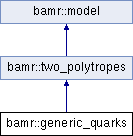|
Bayesian Analysis of Neutron Star Mass and Radius Observations
|
|
Bayesian Analysis of Neutron Star Mass and Radius Observations
|
Generic quark model. More...
Referred to as Model D in Steiner13tn.
This model uses o2scl::eos_had_schematic near saturation, a polytrope (with a uniform prior in the exponent like alt_polytropes) and then a generic quark matter EOS at high densities.
Alford et al. 2005 parameterizes quark matter with
![\[ P = \frac{3 b_4}{4 \pi^2} \mu^4 - \frac{3 b_2}{4 \pi^2} \mu^2 -B \]](form_18.png)
where  is the quark chemical potential. QCD corrections can be parameterized by expressing
is the quark chemical potential. QCD corrections can be parameterized by expressing  , and values of
, and values of  up to 0.4 (or maybe even larger) are reasonable (see discussion after Eq. 4 in Alford et al. (2005)). Note that, in charge-neutral matter in beta equilibrium,
up to 0.4 (or maybe even larger) are reasonable (see discussion after Eq. 4 in Alford et al. (2005)). Note that, in charge-neutral matter in beta equilibrium,  . where
. where  and
and  are the baryon chemical potential and baryon density and
are the baryon chemical potential and baryon density and  is the number density of quarks.
is the number density of quarks.
The parameter  for CFL quark matter, and can thus be positive or negative. A largest possible range might be somewhere between
for CFL quark matter, and can thus be positive or negative. A largest possible range might be somewhere between  , which corresponds to the situation where the gap is zero and the strange quarks receive significant contributions from chiral symmetry breaking, to
, which corresponds to the situation where the gap is zero and the strange quarks receive significant contributions from chiral symmetry breaking, to  which corresponds to a bare strange quark with a large gap. In units of
which corresponds to a bare strange quark with a large gap. In units of  , this corresponds to a range of about
, this corresponds to a range of about  to
to  . In Alford et al. (2010), they choose a significantly smaller range, from
. In Alford et al. (2010), they choose a significantly smaller range, from  to
to  .
.
Simplifying the parameterization to
![\[ P = a_4 \mu^4 +a_2 \mu^2 - B \]](form_34.png)
gives the following ranges
![\[ a_4 = 0.045~\mathrm{to}~0.08 \]](form_35.png)
and
![\[ a_2 = -0.3~\mathrm{to}~0.3~\mathrm{fm}^{-2} \]](form_36.png)
for the "largest possible range" described above or
![\[ a_2 = -0.08~\mathrm{to}~0.08~\mathrm{fm}^{-2} \]](form_37.png)
for the range used by Alford et al. (2010).
The energy density is
![\[ \varepsilon = B + a_2 \mu^2 + 3 a_4 \mu^4 \]](form_38.png)
Note that

#include <models.h>

Public Member Functions | |
| virtual void | low_limits (entry &e) |
| Set the lower boundaries for all the parameters, masses, and radii. | |
| virtual void | high_limits (entry &e) |
| Set the upper boundaries for all the parameters, masses, and radii. | |
| virtual std::string | param_name (size_t i) |
Return the name of parameter with index i. | |
| virtual std::string | param_unit (size_t i) |
Return the unit of parameter with index i. | |
| virtual void | compute_eos (entry &e, int &success, std::ofstream &scr_out) |
Compute the EOS corresponding to parameters in e and put output in tab_eos. | |
| virtual void | first_point (entry &e) |
| Function to compute the initial guess. | |
 Public Member Functions inherited from bamr::two_polytropes Public Member Functions inherited from bamr::two_polytropes | |
| virtual void | setup_params (o2scl::cli &cl) |
| Setup new model parameters. | |
| virtual void | remove_params (o2scl::cli &cl) |
| Remove model-specific parameters. | |
| virtual void | baryon_density_point (double &n1, double &e1) |
| A point to calibrate the baryon density with. More... | |
| two_polytropes () | |
| Create a model object. | |
 Public Member Functions inherited from bamr::model Public Member Functions inherited from bamr::model | |
| virtual void | compute_mr (entry &e, std::ofstream &scr_out, o2scl::o2_shared_ptr< o2scl::table_units<> >::type tab_mvsr, int &success) |
| Compute the M-R curve directly. | |
Additional Inherited Members | |
 Data Fields inherited from bamr::model Data Fields inherited from bamr::model | |
| nstar_cold2 | cns |
| TOV solver and storage for the EOS table. | |
 Protected Attributes inherited from bamr::two_polytropes Protected Attributes inherited from bamr::two_polytropes | |
| o2scl::cli::parameter_double | p_kin_sym |
| Parameter for kinetic part of symmetry energy. | |
| o2scl::eos_had_schematic | se |
| Low-density EOS. | |
| o2scl::fermion | neut |
| Neutron for se. | |
| o2scl::fermion | prot |
| Proton for se. | |
| double | nb_n1 |
| The fiducial baryon density. | |
| double | nb_e1 |
| The fiducial energy density. | |
Documentation generated with Doxygen. Bamr documentation is under the GNU Free Documentation License.